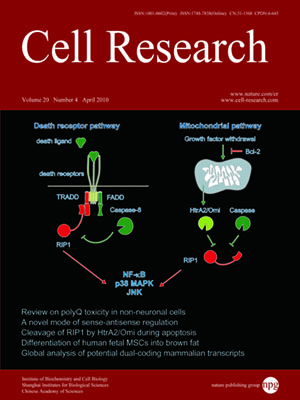
Volume 20, No 4, Apr 2010
ISSN: 1001-0602
EISSN: 1748-7838 2018
impact factor 17.848*
(Clarivate Analytics, 2019)
Volume 20 Issue 4, April 2010: 480-491
ORIGINAL ARTICLES
High doses of α-galactosylceramide potentiate experimental autoimmune encephalomyelitis by directly enhancing Th17 response
Gaochao Qian1,*, Xia Qin1,*, Ying Qin Zang2, Baoxue Ge3, Taylor B. Guo3, Bing Wan3, Lei Fang3 and Jingwu Z. Zhang3
1Shanghai Institute of Immunology, Shanghai JiaoTong University School of Medicine, 280 South Chong Qing Road, Shanghai 200025, China
2Institute for Nutritional Sciences, Shanghai Institute for Biological Sciences, Graduate School of CAS, Chinese Academy of Sciences, 319 Yue Yang Road, Shanghai 200031, China
3Institute of Health Sciences, Shanghai Institute for Biological Sciences, Graduate School of CAS, Chinese Academy of Sciences, 319 Yue Yang Road, Shanghai 200031, China
Correspondence: Jingwu Z. Zhang,(jwzang@sibs.ac.cn)
α-Galactosylceramide (
α-GC) is widely known to activate invariant natural killer T (iNKT) cells to suppress myelin antigen-specific Th1 responses, protecting susceptible mice against experimental autoimmune encephalomyelitis (EAE). Here, we demonstrate an unexpected finding that high doses of
α-GC exacerbated, rather than ameliorated, EAE. Similar results were observed when MOG
35-55-specific T cells treated with high-dose
α-GC were transferred into naïve syngeneic recipient mice. Further study showed that high doses of
α-GC directly enhance the Th17 and Th1 response by activation of CD4
+CD44
+ memory T cells through phosphorylation of STAT3 and activation of NF-κB. Unlike the activation of iNKT cells by low doses of
α-GC, high doses of
α-GC directly interacted with CD1d expressed on T cells and activated Th17 and Th1 cells. Furthermore, antigen-presenting cells (APCs) predominantly express
CD1d1, whereas the majority of CD4
+ T cells express
CD1d2. Knockdown of
CD1d1 or
CD1d2 gene expression by RNAi interfered with the activation of iNKT or Th17/Th1 cells, respectively. Therefore,
α-GC treatment could improve or worsen EAE by engaging either APCs or Th17/Th1 cells depending on the dose used.
Cell Research (2010) 20:480-491. doi: 10.1038/cr.2010.6; published online 19 January 2010
FULL TEXT | PDF
Browse 2057


